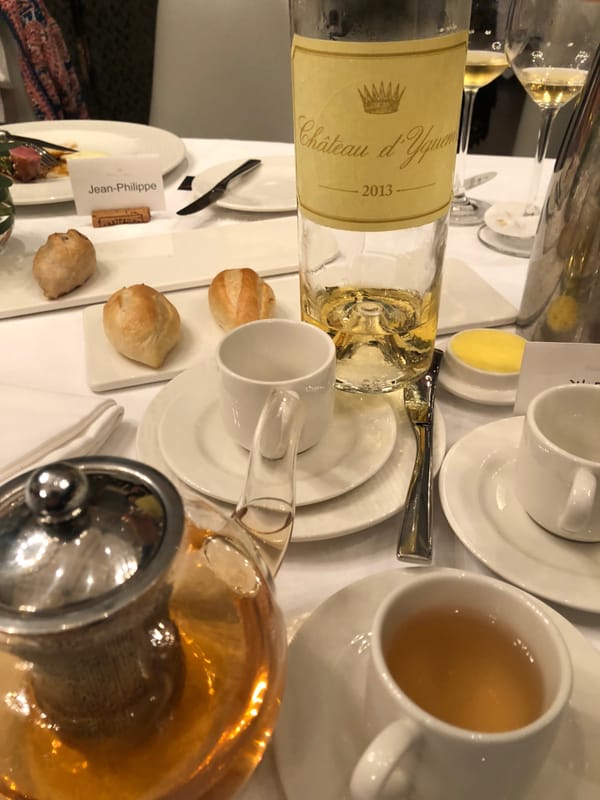What happens when France’s most precious noble rot wine, Château d'Yquem, meets a traditional Chinese Pu’er raw tea cake? At an elegant fine dining event infused with Nordic culinary minimalism, Pu’er tea didn’t just hold its ground—it shone unexpectedly. Its pairing ability astonished even the winery’s general manager.
This was a beautiful experiment in flavor balance and cultural fusion. The lush mystery of noble rot wine, the ethereal beauty of Nordic cuisine, and the wild notes of raw Pu’er tea created a rare “Ichigo-Ichie” moment—a once-in-a-lifetime encounter.
Curious how Pu’er tea expressed the elegance of Eastern tea culture in this high-end culinary scene? Let’s explore this extraordinary performance that transcended both culture and taste.
Château d'Yquem: The Grand Entrance of Noble Rot Wine
Described by the French as “glamorous, complex, and elusive,” Château d'Yquem, from the Sauternes region of Bordeaux, is a legendary wine celebrated at international auctions. When paired with Nordic cuisine, it created a layered flavor journey.
The menu featured caviar, cod, king crab, rose granite, and squid noodles with shrimp consommé. When halibut, cauliflower, brown butter, soy, and nuts met a glass of Château d'Yquem, the fresh, light flavors amplified the curiosity: how would such a luxurious sweet wine complement the meal?
Most remarkable was the squid noodle—seemingly ordinary but actually crafted from squid paste. Combined with the shrimp broth, the oceanic flavors created a savory impact. The honeyed notes of Château d'Yquem elevated the experience, adding a silky, sweet aftertaste.
The Surprising Appearance of Raw Pu’er Tea
While guests were immersed in the lavish world of noble wine, the sudden introduction of a Pu’er raw tea cake surprised everyone. Initially intended as a palate cleanser, the tea revealed far more.
The moment it touched the lips, the tea triggered salivation and freshness. The tannins unfurled with an elegance reminiscent of the Chinese guqin’s melody “High Mountains and Flowing Water” (a classical reference to refined friendship and resonance). Far from a side note, it became a pivotal part of the dinner.
When pork shoulder, citrus sauce, and pickled onions were served, Pu’er’s depth emerged again. Instead of making the meat dry, it introduced a mossy, forest-like aroma that added a new dimension, marrying the wild flavors of the dish in an unexpected harmony.
A Moment of Tea Awakening for Château d'Yquem’s Director
The highlight came when Jean-Philippe Lemoine, the general manager of Château d'Yquem, tasted the Pu’er tea. A black tea drinker by habit, he exclaimed in delight:
“This raw Pu’er tea shares a similar sweetness to Château d’Yquem.”
This observation was powerful. Coming from someone who works with the world’s top wines daily, it reflected a deep resonance. Observing the tea leaves, he asked, “Can the size of the buds tell us the height of the tea tree?”—a winemaker’s instinct, showing sensitivity to raw materials and terroir.
He was struck by Pu’er’s lingering sweetness and tannic charm, recognizing in it a complexity akin to noble wine. It proved that tea and wine, though culturally distinct, can speak the same refined language.
The Trio's Harmony: Noble Wine, Nordic Cuisine, and Pu’er Tea
Originally a supporting character, Pu’er tea became a crucial balancing force among the trio. The noble rot wine offered radiant complexity, the Nordic cuisine provided subtle purity, and Pu’er grounded them with wild elegance.
Nordic minimalism, often misunderstood as simplistic, is in fact deeply refined. Likewise, Château d'Yquem is more than just sweetness—it embodies hidden layers of finesse.
Pu’er tea, with its firm-yet-light body, provided a perfect bridge. Without it, the wine might have felt indulgent, and the cuisine overly airy. Their harmony depended on that precise triangulation.
The Secret of Noble Rot
To understand this event’s elegance, one must first appreciate how noble rot wine is made. When grapes are affected by Botrytis cinerea (noble rot), their water evaporates while sugars and aromas concentrate.
This process demands precise timing: foggy mornings, sunny afternoons, and selective harvesting. Each grape is hand-picked based on its condition. Fermentation is painstaking due to the low moisture and high sugar.
Distinguishing noble rot from gray rot adds to the difficulty. These challenges are why Château d'Yquem is revered in wine circles globally.
A Taste Dialogue Across Cultures
This dinner was more than just a meal—it was a profound dialogue between East and West. The noble rot wine reflected European craftsmanship, the Nordic dishes represented contemporary aesthetics, and the Pu’er tea brought centuries of Chinese tea wisdom.
Rather than compete, they harmonized. Pu’er’s earthy tone deepened the experience. The wine elevated the tea’s elegance. The cuisine created space for both.
Jean-Philippe Lemoine’s praise wasn’t just admiration—it was respect. When he said Pu’er had a Château d'Yquem-like sweetness, he was acknowledging their shared excellence across cultural lines.
Pu’er’s Role in Fine Dining
This dinner opened new possibilities for Pu’er in global gastronomy. In the West, tea is often limited to post-meal service. But this experiment proved that high-quality Pu’er can rival wine as a dining companion.
Its tannic structure, evolving character, and “delicate strength” make it ideal for complex pairings. It doesn’t dominate, yet it enriches.
As foie gras and noble wine make the perfect duo, Pu’er too can be a signature pairing—bringing Eastern depth to modern fine dining.
The Meaning of Ichigo-Ichie
This experience embodied Ichigo-Ichie—the Japanese tea principle that every encounter is unique and unrepeatable.
As Château d'Yquem, Nordic cuisine, and Pu’er tea converged in one fleeting moment, they didn’t just deliver taste—they shared a philosophy. They showed that beauty knows no cultural boundary.
The noble wine unveiled its poetic richness. Pu’er offered clarity of spirit. Nordic food completed the performance with restraint and grace.
True culinary artistry, after all, transcends nations. When we’re open to the unfamiliar, we often find harmony.
In this perfect performance, Pu’er tea became the bridge between worlds.


